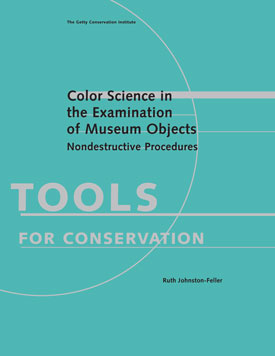
Color Science in the Examination of Museum Objects: Nondestructive Procedures
Ruth Johnston-Feller
2001
365 pages
PDF file size: 19.6 MB
Description
This volume presents the life work of the late Ruth Johnston-Feller, one of the nation’s leading color scientists. It combines an overview of basic theoretical concepts with detailed, hands-on guidance for the professional conservator and conservation scientist.
The author focuses on the application of color science to the solution of practical problems, providing a comprehensive discussion of the nondestructive spectrophotometric tools and techniques used to understand the color and appearance of materials during the technical examination of works of art. The book, which features numerous examples of reference reflectance spectra, can help prevent misinterpretation of color measurements and the erroneous conclusions that might result. Topics include spectrophotometry, colorimetry, colorant mixtures, analytical techniques, reflection, fluorescence, and the effects of extenders, fillers, and inerts.
Table of Contents
- Foreword
- Preface
- Acknowledgments
- Introduction
- Chapter 1: Spectrophotometry
- Spectrophotometers
- Reference Standards
- Instrument Calibration and Measurement Reproducibility
- Spectrophotometric Curves
- Chapter 2: Colorimetry
- Additive Color Mixture, Subtractive Colorant Mixture
- Primary Colors
- The CIE System
- Examples
- Color-Difference Equations
- Tristimulus Filter Colorimeters
- Additional Comments
- Metamerism
- Geometric Metamerism–A Special Case
- Discussion
- Other Color Notation Systems
- Munsell System
- Universal Color Names and Dictionary
- OSA Uniform Color Scales
- Other Systems
- Additive Color Mixture, Subtractive Colorant Mixture
- Chapter 3: Colorant Characteristics
- Chapter 4: Colorant Mixture
- Transparent Materials: The Beer-Bouguer Equation
- Bouguer’s (Lambert’s) Law
- Beer’s Equation (the Beer-Bouguer Equation)
- Absorbing and Scattering Materials: The Kubelka-Munk Equation
- Qualitative Application of the Kubelka-Munk Relationship
- Quantitative Application of the Kubelka-Munk Equation
- Simple Estimation
- More Complex Estimation
- Applications of Kubelka-Munk Formulas
- Study of Colorant Changes
- Vehicle (Medium) or Substrate Change
- Glazes
- Opacity, Translucency, and Hiding Power
- Definitions
- Opacity Calculations
- Scattering, Simple and Multiple
- Charts for Determining Opacity
- Hiding Power
- Tinting Strength: Absorption and Scattering
- Comments on Colorant Calculations and Identifications
- Quantitative Limitations in the Use of the Kubelka-Munk Equation
- Qualitative Applications of the Kubelka-Munk Relationship
- Reflection Density
- Special Scales and Methods Used in Industry
- Applications in the Paper Industry
- Other Single-Number Color Scales
- Transparent Materials: The Beer-Bouguer Equation
- Chapter 5: Color in Specular (Mirror-Type) Reflection
- Color of Metals (Nondielectrics)
- Bronzing
- Pearlescence and Iridescence
- History of Pearlescence and Iridescent Pigments
- Other Flake Pigments (Metallic Flakes)
- Chapter 6: Special Topics
- Surface Reflection
- Refractive Index Differences: The Cause of Surface Reflection
- Matte Surfaces that Exhibit Geometric Metamerism
- Surface Effects on Low-Chroma and High-Chroma Colors
- Types of Gloss
- Surface Changes after Exposure
- Fluorescence
- Color Measurement of Fluorescent Materials
- Historical Use of Fluorescent Pigments
- Development of Modern Fluorescent, High-Visibility Pigments
- Uses of Fluorescent, High-Visibility Pigments by Artists
- Fluorescent Whitening Agents (FWAs)
- Weak Fluorescence of Resins
- Microvoids and Vesiculated Beads
- Extenders, Fillers, Inerts
- Surface Reflection
- Chapter 7: Reflectance Curves of Some Frequently Encountered Chromatic Pigments
- Primary Colors
- Blues
- Reds
- Yellows
- Secondary Colors
- Greens
- Purples
- Oranges
- Pigment Interactions
- Special Technique for Dark or High-Chroma Colors
- Primary Colors
- Chapter 8: Measured-Data Analysis and Special Measurement Problems
- Chapter 9: Instrumentation Overview: The Tasks Determine the Selection
- Material (Sample) Characteristics
- Other Instrument Features
- Reports
- Chapter 10: Suggested Protocol for Recording Spectral Examination Results
- Chapter 11: Summary, Conclusions, and Recommendations
- Appendix A: Curves and Data for Pigments Used as Illustrative Problems
- Appendix B: K/S versus %R Table
- Appendix C: Colour Index Name
- Appendix D: Compilation of Spectral Reflectance Curves of Pigments: Representative Example
- Appendix E: Recommended Reading
- References
- Index
- Illustration Credits
- About the Author
About the Author
Ruth Johnston-Feller was one of the nation’s leading color scientists. She worked for the Pittsburgh Plate Glass Company, the Color Systems Division of Kollmorgen Corporation, and the Ciba-Geigy Corporation, Pigments Division (now Ciba Speciality Chemicals, Colors Division). She later joined the Research Center on the Materials of the Artist and Conservator at the Carnegie Mellon Research Institute, Carnegie Mellon University.